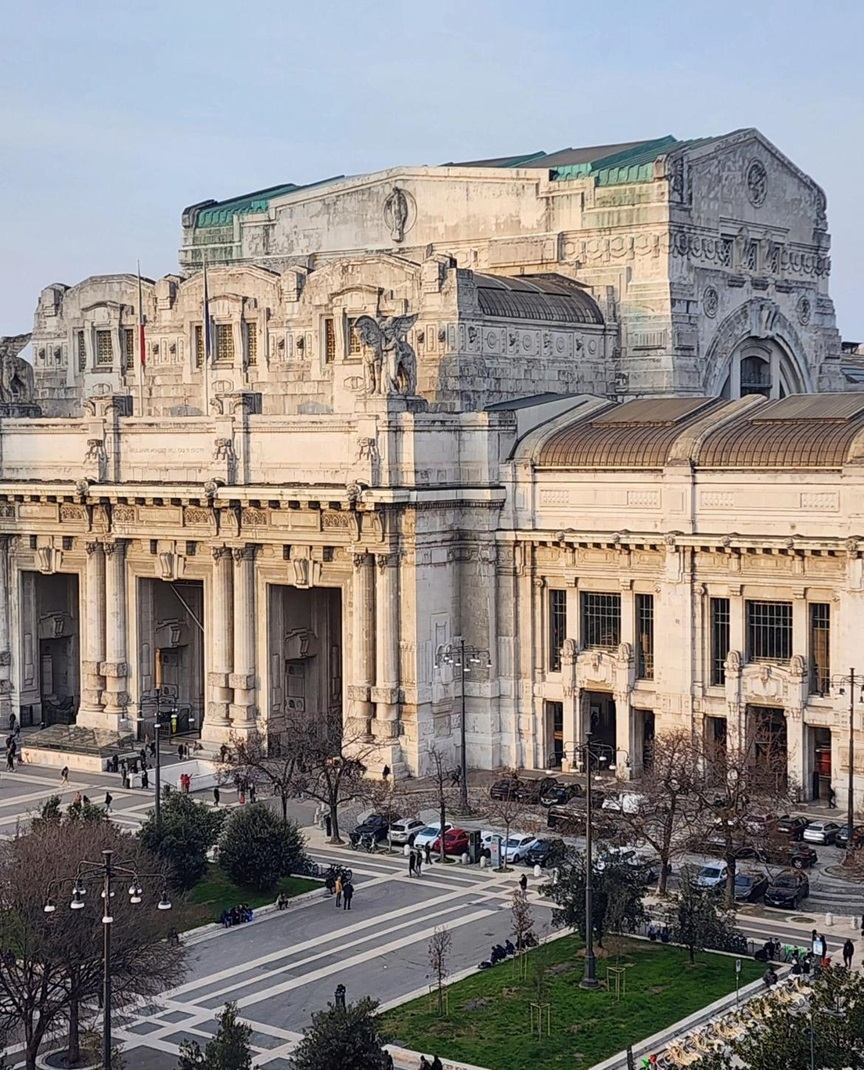The Central Station, along with the surrounding neighborhood, is located to the northeast of the city center, behind the Porta Venezia gardens. It serves as the gateway to the city for travelers from all over Italy and the world.
At Central Station, you’ll find the metro (linesM2 and M3), the tram (lines 5, 9, 10), and the bus (lines 42, 60, 81, 87). You will also find connections to all airports, both by train and bus.
Milan Central Railway Station
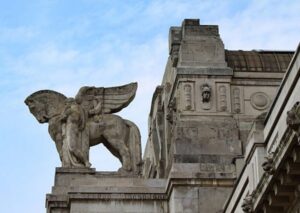
The monumental Assyrian-Babylonian-style building housing the train station was inaugurated in the summer of 1931. In those same years, the station was completely redeveloped and renovated. Central Station is undoubtedly one of the most imposing and iconic buildings in Milan. Everyone passes through it at least once! The tall structures, mosaics, and monumental statues, along with the large iron and glass vaults that tower over the tracks, will give you a warm welcome whether you’re arriving or departing.
Holocaust Memorial, Platform 21
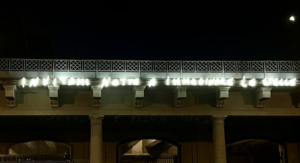
This is a significant site dedicated to the memory of the victims of the Holocaust. Located beneath Milan’s Central Station at Platform 21, the memorial marks the place from which Jews and other persecuted individuals were deported during World War II to concentration and extermination camps such as Auschwitz and Bergen-Belsen, between 1943 and 1945. The Holocaust Memorial, inaugurated in 2013, includes a museum space where visitors can see the original train tracks, cattle cars used for deportations, and various historical documents, photographs, and testimonies. It offers an immersive and reflective experience, designed to remember the victims of the Holocaust and educate future generations about the horrors of this dark period in history. A key element of the memorial is the Wall of Names, which lists the names of those deported from Milan.
Royal Pavillon
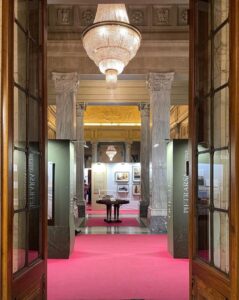
The Royal Pavilion at Milan’s Central Station is one of the station’s most elegant and historic features. This pavilion, located in a separate and reserved area of the station, was originally built to host the royal family and distinguished visitors to Milan. The pavilion is noted for its Art Nouveau architecture and luxurious interiors, with waiting rooms adorned with frescoes, stuccoes, and prestigious furnishings. This space was used to solemnly receive monarchs and other prominent figures, offering them an exclusive place to wait for their train’s arrival or departure.
Though no longer serving its original purpose, the Royal Pavilion remains a testament to the historical importance of Milan’s Central Station, which continues to be one of Europe’s key railway hubs. Access to the pavilion is limited to special occasions or guided tours, making it a point of interest for history and architecture enthusiasts. It can be visited during specific events such as the FAI Spring or Autumn Days, or other days dedicated to cultural heritage.
Pirellone
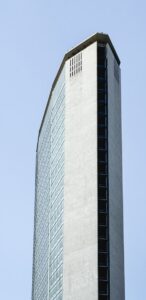
Officially known as the Pirelli Tower (Torre Pirelli), is one of Milan’s most iconic skyscrapers. Completed in 1960, it was designed by architect Gio Ponti, with structural engineering by Pier Luigi Nervi, and is considered a masterpiece of modernist architecture. Standing at 127 meters (416 feet), the tower was, for many years, the tallest building in Italy and remains a significant symbol of Milan’s post-war economic boom. The building was commissioned by Pirelli Company, one of Italy’s most famous industrial firms, and originally housed their headquarters.
The tower’s sleek, minimalistic design, featuring a narrow footprint and tapering edges, was revolutionary at the time. Its glass and concrete facade, along with its diamond-shaped floor plan, gives it a distinct look. The tower represents the blend of architectural beauty and engineering precision, and its influence can be seen in skyscrapers around the world.
Piazza della Repubblica
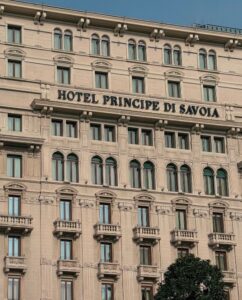
Historically, the area was once home to Milan’s old central railway station, which was replaced by Stazione Centrale in the early 20th century. The square is surrounded by a mix of modern skyscrapers, luxury hotels, and offices, reflecting the city’s economic growth. The iconic Hotel Principe di Savoia, one of Milan’s most famous luxury hotels, is located here. The Hotel Principe di Savoia is one of Milan’s most prestigious and historic luxury hotels. Opened in the 1920s, the hotel has been a symbol of elegance and refinement, catering to high-profile guests, including celebrities, political figures, and royalty. The hotel combines classic Italian style with modern luxury, offering opulent rooms and suites, many featuring lavish furnishings, marble bathrooms, and stunning city views. The interiors are adorned with rich fabrics, fine art, and classic decor that evoke the grandeur of traditional Milanese luxury.
Monument to Giuseppe Mazzini by Pietro Cascella
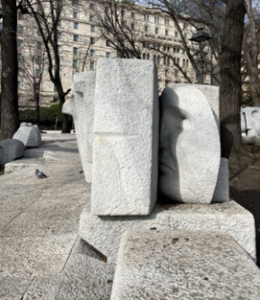
Located on a busy but unnoticed place, just in front of Hotel Principe di Savoia you can find a Monument dedicated to Giuseppe Mazzini. The complex of sculptures was designed by the Italian sculptor and painter Pietro Cascella and built in 1974. This monument in marble and stone is considered the symbol of the path towards the unification of Italy and in fact each sculpture represents a phase.
Casa Museo Boschi di Stefano
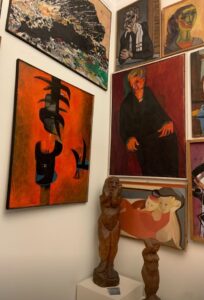
Casa Boschi di Stefano is a house-museum in Milan, located at 15 Via Giorgio Jan. It was once the residence of Antonio Boschi and Marieda Di Stefano, two art collectors who amassed an extraordinary collection of 20th-century Italian art, which they donated to the city of Milan.
The collection includes masterpieces by artists such as Giorgio de Chirico, Lucio Fontana, Piero Manzoni, Mario Sironi, and many others. The house itself is an interesting example of 1930s rationalist architecture. Today, the interiors are preserved almost exactly as they were when the couple lived there, with period furniture and artworks adorning the walls.
Teatro Elfo Puccini
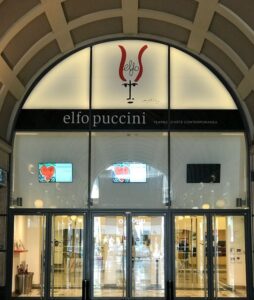
A prominent theater in Milan, known for its innovative and contemporary productions. It was renovated and reopened under its current name in 2009, becoming one of the leading venues for avant-garde theater in Milan. Founded by the Elfo Theatre Company in 1973, the theater has a reputation for hosting bold, experimental, and socially relevant performances. It offers a varied program, including Italian and international plays, contemporary drama, and productions that tackle modern issues.

